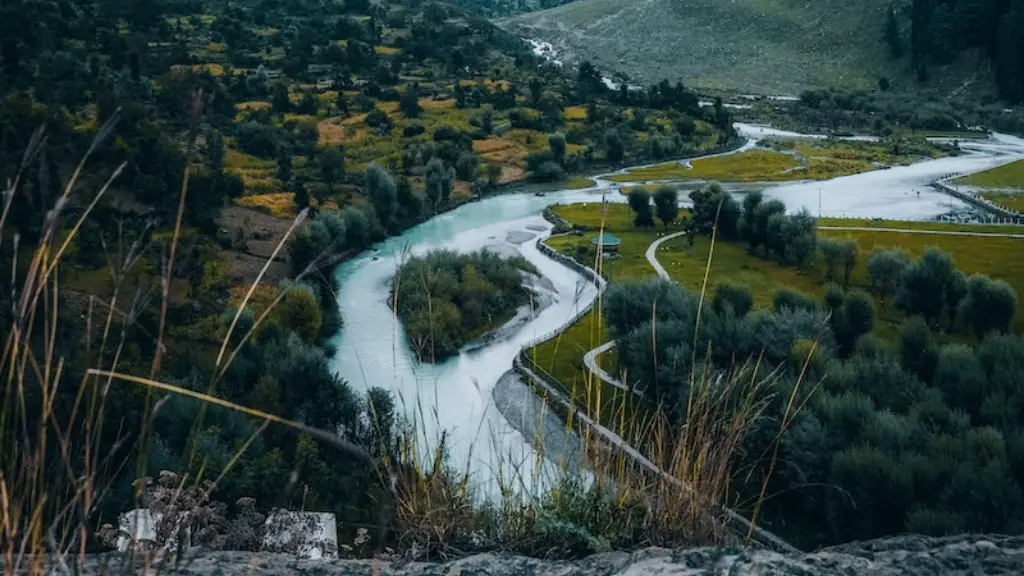Introduction- The Importance of the Mississippi River
The Mississippi river is one of the most important rivers in the world, forming a vital part of the United States’ infrastructure and economic prosperity. It links the northern Midwest with the Gulf of Mexico and is essential for transporting everything from grain and crude oil to chemicals, coal, and other essential materials. The river is also the lifeblood of a variety of plant and animal species, providing crucial spawning habitats, wetlands, and other essential eco-systems. It is imperative to examine how this mighty river flows and continues to be an essential part of life in the United States.
How The Mississippi River Flows
The Mississippi River receives water from a number of sources, including Lake Itasca, south of the Canadian border, to the Mississippi Delta in the Gulf of Mexico. Water from the Missouri and Ohio Rivers, as well as the Great Lakes all contribute to the flow of the Mississippi. The Mississippi is 2,320 miles long, making it the second-longest river in the United States.
The river can flow as swiftly as 4.5 mph, with a slow drift of only 0.2 mph. During extreme floods, the river can widen to over 9 miles in width and extend nearly 2 miles in depth. The main currents can move up to 8 mph and are directed against the banks of the Mississippi River in order to prevent erosion and silting.
The Effects of Human Activity on Mississippi River Flow
Humans have had a disturbing effect on the Mississippi river flow, primarily through the construction of over 4,000 dams, the digging of canals, and the dredging of sediments. All of these activities have led to a decreasing width of the river’s main channels because it has become impounded by the dams. This has led to an increase in sediment deposits into the river, as well as a reduced flow speed.
In addition, humans have depleted wetlands throughout the river’s length, reducing the amount of water held by vegetation. This has led to a decrease in flood resilience, as well as an overall decrease in water flow. Furthermore, large cities and farms situated around the river have created a large amount of polluted runoff, which is damaging the health of the river.
Changes in Mississippi Flow due to Climate Change
Climate change is also affecting the flow of the Mississippi as temperatures rise and weather patterns become more unpredictable. Warmer temperatures lead to higher evaporation rates, which reduces the amount of water in the river. More extreme weather patterns have led to increased flooding, which again affects the flow of the river.
Increases in precipitation can also overload the river with too much water, and the flooding that ensues can be drastic, washing away homes and businesses. This can also cause the river to flood further downstream, damaging the infrastructure that is built along the floodplain.
Mississippi River Restoration Measures
In efforts to combat the effects of climate change and human activity on the Mississippi river, entities such as the United States Corps of Engineers and environmental organizations are working to restore and protect the river’s ecosystems. Building new levees, restoring wetlands, and removing sediment deposits are all being done in order to maintain the rivers health and flow.
The Federal government has taken steps to regulate the flow of the river, limiting water depletion from cities and farms, restoring flood plains, and regulating dredging in order to create a more natural flow of the river. Furthermore, laws have been passed to protect wildlife and the general health of the Mississippi.
Are the Restoration Measures Effective?
Although these restoration measures are laudable, they are not enough to restore the river’s health. Scientists have argued that the only way to truly prevent further damage to the Mississippi is to reduce the amount of chemicals and pollutants being released into the river by eliminating large-scale water extraction, reducing runoff from farms and cities, and limiting dredging and other river interventions.
That being said, if all of these solutions are implemented correctly, the Mississippi River could be restored to its past glory, providing sustenance to local communities and habitats, as well as improving the lives of those who rely on the river for their livelihoods.
Impact of the Mississippi River on Economic Activity
The Mississippi River has long been an important part of the American economy, providing navigable waterways to and from the Gulf of Mexico as well as a source of much-needed agriculture. Many small towns and farms depend on the river as a source of income and sustenance, as the river is an essential part of the local ecosystem.
The river is a major freight artery, providing transportation of goods between the Midwest and the South. In fact, over 150 million tons of cargo are transported annually on barges alone. This income is essential for a variety of businesses, including those in the logistics and petroleum industries.
Shipping and the Flow of the Mississippi River
The flow of the Mississippi river has an immense effect on the various industries using the river for shipping. During times of low water, for instance, vessels may need to be adjusted to be able to navigate the river as the draft may be shallow. In addition, increased sedimentation from dams and diversion of the river can also impede navigation. In some cases, it may even be necessary to dredge the river in order to ensure its navigability.
This is why it is essential that the river continues to flow at its optimum levels. Minimizing the effects of human activities and climate change on the Mississippi river is essential for ensuring that shipping continues to be viable and efficient.
The Role of Artificial Intelligence in Improving Flow
In recent years, artificial intelligence and other digital technologies have been used to improve the flow of the Mississippi River. Through the use of sensors and analytics, AI has been used to detect shifts in the river’s flow, sediment levels, and other environmental conditions more efficiently.
It has also been used to develop predictive models that can help to identify potential flood zones and model the potential effects of changing climate and human activity on the river. These technologies are essential for ensuring the Mississippi river flow remains at its optimal levels.
Environmental Impact of Mississippi River Flow
The Mississippi River is home to a variety of wildlife and plants, some of which are at risk of extinction due to the effects of humans and climate change. The river’s flow affects the spawning grounds of many species, such as mussels and sturgeon, as well as providing important habitat for numerous birds and aquatic life.
By understanding the flow of the river, management can better ensure that ecosystems are protected and the river remains a source of life for its inhabitants for years to come.
Conclusion
It is clear that the Mississippi River flow is of paramount importance to the United States. It forms the backbone of its economy, providing essential transportation and sustenance to countless communities and is essential to the health of its local ecosystems.
It is essential that we understand how the Mississippi River flows so we can ensure that its health is preserved, the effects of human activities are minimized, and the effects of climate change are taken into account. With effective management, the river can continue to thrive, providing essential resources and habitats to local ecosystems and communities.


